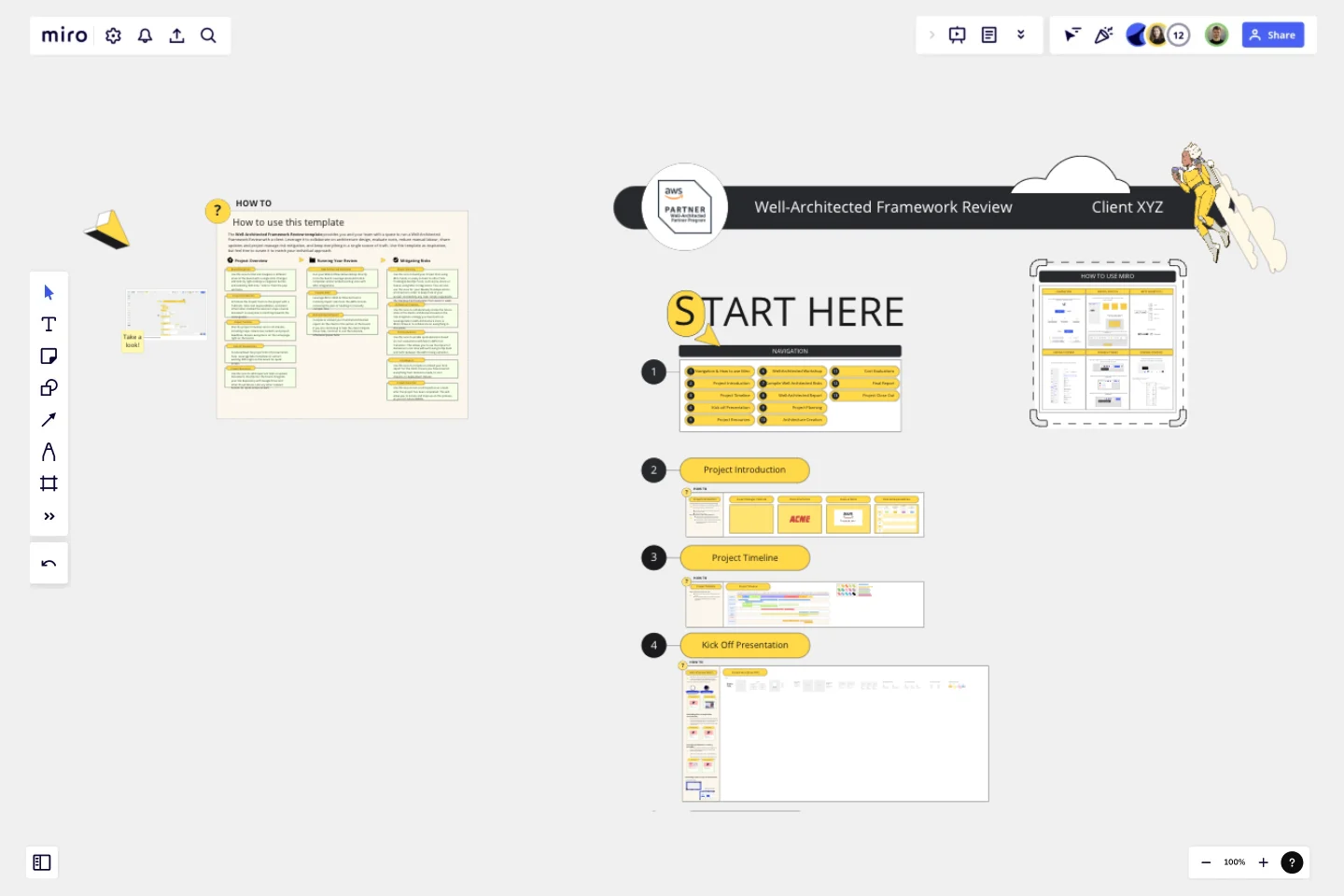Miro for AWS Well-Architected Framework Reviews
This AWS Well-Architected Framework Review (WAFR) template provides you and your team with a dedicated space to conduct a Well-Architected Framework Review with a client.
Utilize this template to:
Collaborate on architecture design
Evaluate architecture costs
Reduce manual labor
Share updates and project manage risk mitigation
Maintain a single source of truth throughout the entire engagement
Feel free to use this template as a starting point and customize it to align with your unique approach.
The template includes various sections to support different aspects of a WAFR:
Board Navigation: Navigate different areas of the board with a single click. To change or add links, right-click a navigation button and select 'Edit Link' or 'Link to' from the pop-up menu.
Project Timelines: Plan project timelines across all streams, including major milestones, kickoffs, and deadlines. This ensures everyone is aligned right on the board.
Project Introduction: Introduce the project team to the project with a talk track, roles and responsibilities, and client information. Embed the relevant scope of work document to align everyone with the same goals.
Project Kickoff Presentation: Create or embed the project kickoff presentation here. Use Miro templates or import existing PDFs directly onto the board for easy access.
Well-Architected Workshop: Conduct your Well-Architected workshop directly from the board using pre-built format templates or embed existing ones with Miro integrations.
Import Risks from AWS Console: Instantly import risks from the AWS console using Miro's Well-Architected tool, eliminating the need to manually compile risks.
Future State Architecture: Collaboratively design the client's future state architecture based on the risk mitigation strategy. Use Miro's AWS Architecture Icons or Draw.io for collaboration in one place.
Important Links and Documents: Add important links or upload documents directly to the board. Integrate your file repository with Google Drive and other cloud services. Link to any other relevant boards for quick access.
Final Well-Architected Report: Compile or embed the final Well-Architected report for the client in this section. If you're continuing to assist the client with risk mitigation, keep using the template; otherwise, this is where you pause.
Project Plan and Weekly Standups: Build your Project Plan using Miro Cards, or connect to other task tracking and DevOps tools like Jira, Azure, or Asana with Miro's integrations. Use this area for weekly standups to track progress and identify risks. Simply copy and paste the Standup Card templates from week to week.
Cost Evaluations: Make quick decisions based on cost evaluations with Miro's AWS Cost Calculator, allowing you to see the impact of decisions in real-time without toggling between tools.
Final Client Report: Compile or embed your final report for the client here, ensuring all aspects from decisions made to cost impacts and deployment statuses are covered.
Retrospective: Conduct a retrospective with your team after project completion to iterate and improve the process for future WAFRs.
This template was created by Jesse G.
Get started with this template right now.
Project Organizational Chart Template
Works best for:
Project Management, Documentation, Org Charts
When you’re embarking on a long, complex project, you will inevitably hit roadblocks and obstacles. It’s important to have your project organizational chart on hand to overcome those challenges. A project organizational chart is a visual diagram that illustrates who is on your team and the role they play in a given project. It documents the structure of the project organization, the hierarchy between team members, and the relationships between employees. Project organizational charts are useful tools for clarifying who does what, securing buy-in, and setting expectations for the group.
Critical Path Method Template
Works best for:
Diagramming, Project Management
Elevate your project management game with the Critical Path Method Template—an indispensable tool that brings clarity and precision to your project timelines. The template instantaneously adjusts as you edit tasks and dependencies, ensuring that your critical path is consistently up-to-date. This capability not only simplifies the complex process of project scheduling but also empowers your team to proactively respond to evolving project dynamics, fostering adaptability and efficiency throughout the project lifecycle.
UML Component Diagram Template
Works best for:
Mapping, Diagrams, Software Development
Use our Component Diagram template to show how a system’s physical components are organized and wired together. Visualize implementation details, make sure planned development matches system needs, and more — all in a collaborative environment.
Web Diagram Template
Miro's Web Diagram Template simplifies complex project organization and promotes effective communication. It allows users to easily connect elements and gain a comprehensive understanding of complex relationships, making it a versatile and invaluable asset for diverse projects.
Bracket Template
Works best for:
Diagramming
The Bracket Template is a dynamic visualization tool that helps to organize and rank ideas, entities, or teams in a sequential and competitive manner. It is structured like a tree, starting with multiple entries on either side, which then face off in successive rounds, leading to a single winner or conclusion. One of its standout benefits is its ability to simplify complex decision-making processes. Breaking down choices into smaller, head-to-head comparisons, makes the path to a final decision clearer, ensuring clarity and fostering engagement among participants. Moreover, the Bracket Template is particularly useful when there are multiple options to consider and when there is a need to compare and contrast those options. It is an effective way to streamline decision-making, making it easier and more efficient.
